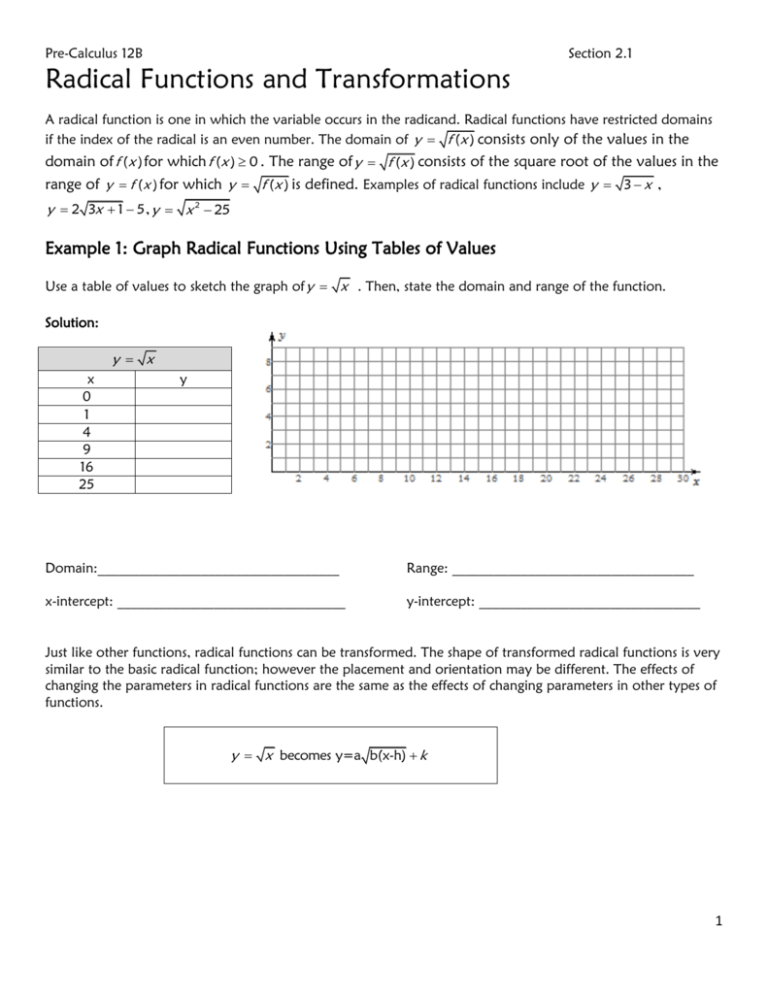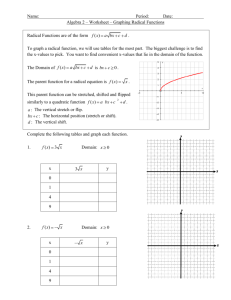Notes Section 2.1 Radical Functions and - FHS
advertisement

Pre-Calculus 12B Section 2.1 Radical Functions and Transformations A radical function is one in which the variable occurs in the radicand. Radical functions have restricted domains if the index of the radical is an even number. The domain of y f (x ) consists only of the values in the domain of f (x ) for which f (x ) 0 . The range of y f (x ) consists of the square root of the values in the range of y f (x ) for which y f (x ) is defined. Examples of radical functions include y 3 x , y 2 3x 1 5 , y x 2 25 Example 1: Graph Radical Functions Using Tables of Values Use a table of values to sketch the graph of y x . Then, state the domain and range of the function. Solution: y x x 0 1 4 9 16 25 y Domain:___________________________________ Range: ___________________________________ x-intercept: _________________________________ y-intercept: ________________________________ Just like other functions, radical functions can be transformed. The shape of transformed radical functions is very similar to the basic radical function; however the placement and orientation may be different. The effects of changing the parameters in radical functions are the same as the effects of changing parameters in other types of functions. y x becomes y=a b(x-h) k 1 Pre-Calculus 12B Example 2: Graph Radical Functions Using Transformations Section 2.1 Sketch the graph of each function using transformations. Determine the domain and range of each function. a. y 3 (x 1) b. y 2x 3 f (x ) 2 4(x 2) 5 c. Solution: a. y 3 (x 1) Mapping Rule: ___________________________________________ y x x 0 1 4 9 16 25 y y 3 (x 1) x y Domain of y 3 (x 1) : _______________________________ Range of y 3 (x 1) : _________________________________ 2 Pre-Calculus 12B b. y 2x 3 Section 2.1 Mapping Rule: ____________________________________ y x x 0 1 4 9 16 25 y y 2x 3 x y Domain of y 2x 3 : _________________________________ Range of y 2x 3 : __________________________________ f (x ) 2 4(x 2) 5 c. Mapping Rule: ________________________________ Domain of f (x ) 2 4(x 2) 5 ________________ Range of f (x ) 2 4(x 2) 5 : _____________ y x x 0 1 4 9 16 y f (x ) 2 4(x 2) 5 x y 3 Pre-Calculus 12B Section 2.1 Example 3: Determine a Radical Function From a Graph Use the graph below to write the equation of the corresponding radical function in the form y=a b(x-h) k You can use the endpoint and the coordinates of another point of the transformed function to determine the equation. Identify the endpoint of the transformed function: ________ The endpoint represents the parameters (h,k) There is no reflection in the x-axis or y-axis. The graph is stretched. This stretch can be viewed as being either a horizontal or vertical stretch. To determine the factor by which the graph has been stretched, begin by identifying one other point that the graph passes through. View as a Vertical Stretch View as a Horizontal Stretch Substitute h, k, x, and y into y=a (x-h) k and solve for a. Substitute h, k, x, and y into y= b(x-h) k and solve for b. a= b= Equation of the function: Equation of the function: ________________________________________ ______________________________________ 4







